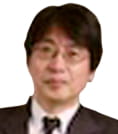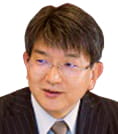- JST Home
- /
- Strategic Basic Research Programs
- /
 CREST
CREST- /
- Research Director/
- Elucidation of biological mechanism of extracellular fine particles and the control system/
- [Extracellular Fine Particles] Year Started : 2017
[Extracellular Fine Particles] Year Started : 2017
Hidetaka Akita
Control of intra-lymphatic trafficking and nanoparticle communication for the discovery of an innovative DDS
Research Director
Hidetaka Akita

Professor
Graduate School of Pharmaceutical Sciences
Tohoku University
Outline
The goal of this project is to develop a nanotechnology that can control lymphatic system trafficking and communication with its component cells, such as antigen presenting cells and lymphatic endothelial cells. To achieve this goal, we plan to use ss-cleavable and pH-activated lipid like materials (ssPalm), in which the tertiary amine structure is positively charged in response to the acidic pH in endosomes, and disulfide bonding linkages are cleaved in response to the reducing environment in cytoplasm. This project consists of three parts. First, the relationship between the physicochemical properties of the nanoparticle and inter-lymph node transport and/or distribution in lymph node will be systematically investigated by using an original mouse model. Second, the interactions of and communications of the nanoparticle with lymphatic endothelial cells will be controlled. The findings will provide detailed information regarding the biological nature of extracellular vesicles. Our final objective will be to develop a vaccine platform by controlling intra-lymphatic transport and antigen presenting cells.
Kazunari Akiyoshi
Elucidation of diversity of exosomes focused on carbohydrates and basic research for biological response and control
Research Director
Kazunari Akiyoshi

Project Professor・Professor Emeritus
Graduate School of Medicine
Kyoto University
Collaborator
| Koji OTSUKA | Professor Graduate School of Engineering Kyoto University |
| Naohiro SEO | Research Associate Professor Graduate School of Medicine Mie University |
| Hiroaki Tateno | Group Leader Cellular and Molecular Biotechnology Research Institute National Institute of Advanced Industrial Science and Technology |
| Koichi Furukawa | Snior Research Professor College of Life and Health Sciences Chubu University |
Outline
Cellular carbohydrates are involved in various biological responses such as development, immunity, infection and carcinogenesis. It is conceivable that carbohydrates on exosomal surface also play an important role in life phenomena. In this project, we develop biosciences in exosomal carbohydrates related to structural and functional diversity of exosomes, and new technology for separation and isolation of exosomes. Researches, which focused on functions of carbohydrates, into elucidation and control of biological production process of exosomes, intracellular delivery, and in vivo tissue distribution of exosomes will be promoted for medical applications in addition to biological researches in exosomes.
Makoto Sawada
Signal peptides; potential bio-markers for exosomes
Research Director
Makoto Sawada

Professor
Research Institute of Environmental Medicine
Nagoya University
Collaborator
| Koji Sakamoto | Assistant Clinical Professor Hospital Nagoya University |
Outline
Micro particles in the environment induce various biological actions, and at the same time the organism also produces biological micro particles called exosomes and biological responses such as defense reactions occur. We have discovered that exosomes contain a large amount of peptide molecules by our proprietary hot melt-mass spectrometry. Conducting mass spectrometry in combination with an original technology that can efficiently isolate micro particles, we aim to develop a new method to elucidate their biological roles and to control the biological reactions caused by extracellular micro particles.
Mitsunori Fukuda
Analysis of formation and secretion of extracellular vesicles and their heterogeneity: applications for artificial extracellular vesicles
Research Director
Mitsunori Fukuda

Professor
Graduate School of Life Sciences
Tohoku University
Outline
Cells in the human body communicate with each other partly through secretion of small extracellular vesicles such as exosomes that contain various proteins, lipids, and nucleotides. However, the detailed molecular mechanism by which cells respond to extracellular vesicles is still poorly understood. In addition, a thorough understanding of the heterogeneity of extracellular vesicles in terms of their size, content, and function remains unclear. The aim of this study is to elucidate the fundamental mechanism of the formation and secretion of extracellular vesicles. We will also investigate the key molecular device behind the heterogeneity of extracellular vesicles with particular emphasis on the two key membrane trafficking regulators, the ESCRT complex and the small GTPase Rab. Eventually, these mechanisms will be employed for developing new technologies that produce artificial extracellular vesicles/particles, which contain functional molecules.
Jun Yamashita
Elucidation of novel cellular synchorization phenomenon mediated by exosomes that regulates differentiation and regeneration, and manipulation of cellular synchronization with nano-particles
Research Director
Jun Yamashita

Professor
Graduate School of Medicine and Faculty of Medicine
The University of Tokyo
Collaborator
| Tetsuya MATOBA | Lecturer Cardiovascular Medicine Kyushu University Hospital |
Outline
Now we found a novel phenomenon in which cells conduct their own cellular status to neighboring cells through extracellular small vesicles called “exosomes” to synchronize all these cellular status. We call this “cellular synchronization”. By elucidating the molecular mechanisms of cellular synchronization and applying these knowledges to nano-particle technologies, we are aiming to develop new methods that can manipulate various cellular biological functions both in vitro and in vivo. This research would contribute to explore novel regenerative therapies in the near future.
Tamotsu YOSHIMORI
Response to and formation of extracellular fine particles by autophagy
Research Director
Tamotsu YOSHIMORI

Professor
Graduate School of Frontier Biosciences
Osaka University
Collaborator
| Kensuke IKENAKA | Assistant Professor Graduate School of Medicine Osaka University |
Outline
Autophagy is the system sequestering and degrading various staffs inside cells. When cells engulf harmful particles including silica and ureic acid crystal, autophagy sequesters them. We aim to elucidate its mechanisms and how cells treat the sequestered particles in this project. On the other hands, there is a possibility that autophagy forms particles to release intracellular staffs into outside of cells. We will investigate if it is true.













